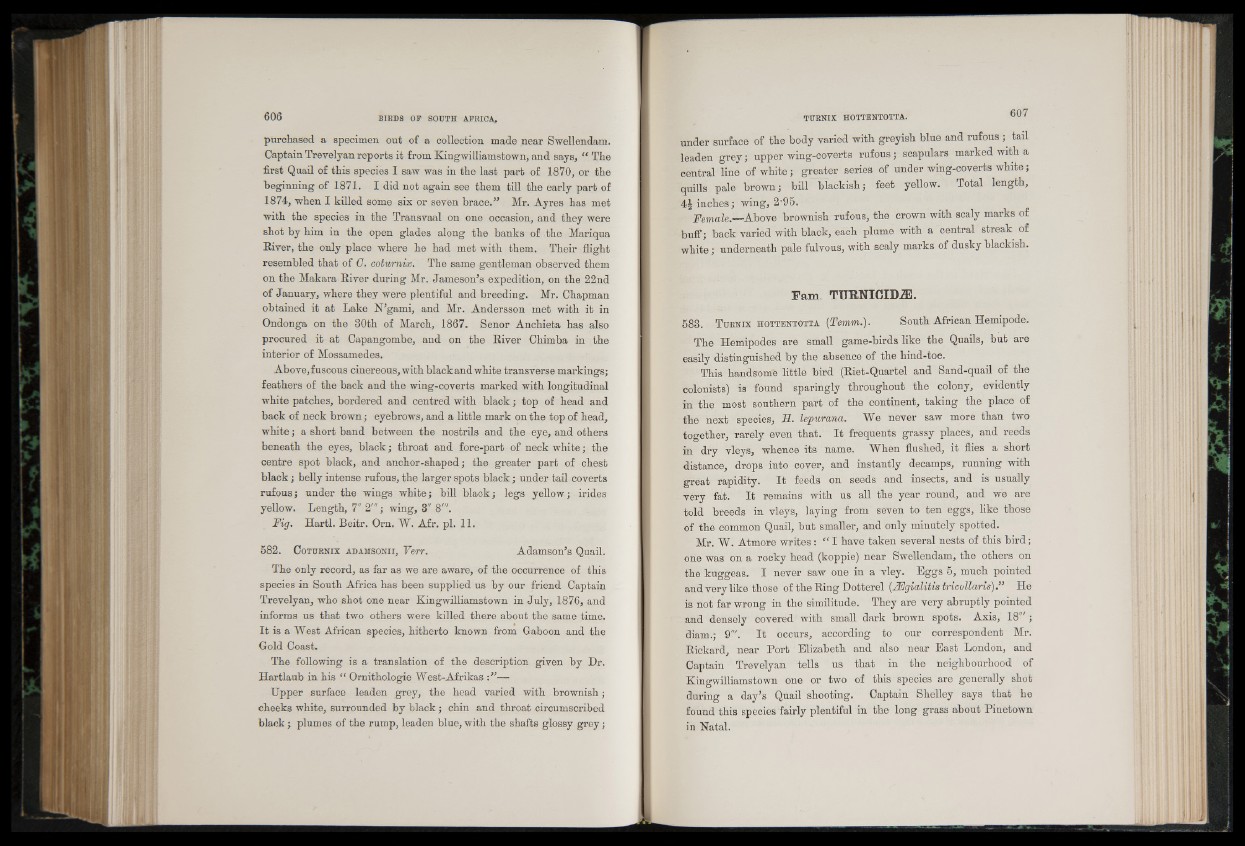
purchased a specimen out of a collection made near Swellendam.
Captain Trevelyan reports it from Kingwilliamstown, and says, ” The
first Quail of this species I saw was in the last part of 1870, or the
beginning of 1871. I did not again see them till the early part of
1874, when I killed some six or seven brace.” Mr. Ayres has met
with the species in the Transvaal on one occasion, and they were
shot by him in the open glades along the banks of the Mariqua
River, the only place where he had met with them. Their flight
resembled that of G. coturnix. The same gentleman observed them
on the Makara River during Mr. Jameson's expedition, on the 22nd
of January, where they were plentiful and breeding. Mr. Chapman
obtained it at Lake N’gami, and Mr. Andersson met with it in
Ondonga on the 30th of March, 1867. Senor Anchieta has also
procured it at Capangombe, and on the River Chimba in the
interior of Mossamedes.
Above, fuscous cinereous, with black and white transverse markings;
feathers of the back and the wing-coverts marked with longitudinal
white patches, bordered and centred with black; top of head and
back of neck brown; eyebrows, and a little mark on the top of head,
white; a short band between the nostrils and the eye, and others
beneath the eyes, black; throat and fore-part of neck white; the
centre spot black, and anchor-shaped; the greater part of chest
black; belly intense rufous, the larger spots black; under tail coverts
rufous; under the wings white; bill black; legs yellow; irides
yellow. Length, 7" 2"'; wing, 3" 8"'.
Fig. Hartl. Beitr. Om. W. Afr. pi. 11.
582. C o t u r n ix a d a m s o n i i , Verr. Adamson’s Quail.
The only record, as far as we are aware, of the occurrence of this
species in South Africa has been supplied us by our friend Captain
Trevelyan, who shot one near Kingwilliamstown in July, 1876, and
informs us that two others were killed there about the same time.
It is a West African species, hitherto known from Gaboon and the
Gold Coast.
The following is a translation of the description given by Dr.
Hartlaub in his “ Ornithologie West-Afrikas —
Upper surface leaden grey, the head varied with brownish;
cheeks white, surrounded by black; chin and throat circumscribed
black; plumes of the rump, leaden blue, with the shafts glossy grey;
under surface of the body varied with greyish blue and rufous ; tail
leaden grev; upper wing-coverts rufous; scapulars marked with a
central line of white; greater series of u n d e r wing-coverts white;
quills pale brown; bill blackish; feet yellow. Total length,
4 | inches; wing, 2’95.
Female.—Above brownish rufous, the crown with scaly marks of
buff; back varied with black, each plume with a central streak of
white; underneath pale fulvous, with scaly marks of dusky blackish.
Fam. TURNICID2E.
583. T u r n ix h o t t e n t o t t a (Temm.). South African Hemipode.
The Hemipodes are small game-birds like the Quails, but are
easily distinguished by the absence of the hind-toe.
This handsome little bird (Riet-Quartel and Sand-quail of the
colonists) is found sparingly throughout the colony, evidently
in the most southern part of the continent, taking the place of
the next species, S . lepurana. We never saw more than two
together, rarely even that. It frequents grassy places, and reeds
in dry vleys, whence its name. When flushed, it flies a short
distance, drops into cover, and instantly decamps, running with
great rapidity. I t feeds on seeds and insects, and is usually
very fat. It remains with us all the year round, and we are
told breeds in vleys, laying from seven to ten eggs, like those
of the common Quail, but smaller, and only minutely spotted.
Mr. W. Atmore writes: “ I have taken several nests of this bird;
one was on a rocky head (koppie) near Swellendam, the others on
the kuggeas. I never saw one in a vley. Eggs 5, much pointed
and very like those of the Ring Dotterel (Jflgialitis tricollaris).” He
is not far wrong in the similitude. They are very abruptly pointed
and densely covered with small dark brown spots. Axis, 18 ;
diam.; 9'". I t occurs, according to our correspondent Mr.
Rickard, near Port Elizabeth and also near East London, and
Captain Trevelyan tells us that in the neighbourhood of
Kingwilliamstown one or two of this species are generally shot
during a day’s Quail shooting. Captain Shelley says that he
found this species fairly plentiful in the long grass about Pinetown
in Natal.